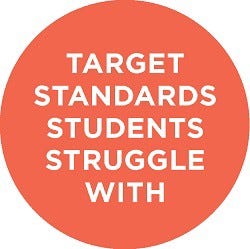Breakthroughs: Using Data to Target Student Growth
Can educators really offer individualized homework for every student in class in an efficient and meaningful way? Yes.

Using readily available data to target the standards that our students struggle with makes differentiating homework assignments absolutely possible.
— Bernadette Scheetz
As educators, we know that every student has individual learning needs. But can educators really offer individualized homework for every student in class in an efficient and meaningful way?
We want every child who enters our classroom to succeed. But we know that not every student is ready to learn grade-level curriculum. Using readily available data to target the standards that our students struggle with makes differentiating homework assignments absolutely possible.

We’re inundated with data from the state, the county, and our own assessments — but we can make it work for us by selecting the right data to target the skill that each individual student needs.
Here’s my step-by-step approach to individualizing homework assignments:
1. I begin by looking at the Common Core State Standards targeting the major clusters in my current unit. Backtracking, I map what standards supported these major clusters in previous grades; looking ahead, I see what standards the clusters support in future grades. Once I target the standards I want to build upon and support, I dig in to the data.
2. Since the supporting standards were taught in previous grade levels, I look back at the lagging data which includes state assessments to see generally low-performing standards.
3. Next, I look at my county’s data warehouse, which tags questions by a specific standard for all county assessments.I download that data to a spreadsheet to see just how well each student performed. Whenever a student is on the border of needing additional practice on a standard, I refer to the state assessment results to see if that standard was a generally low-performing one.
4. Using the data, I create a folder for each student. In the folder is a progress organizer that lists the standard in student-friendly language and the date of the assignment, plus the assignment and a notes section for feedback to the student.

Now I know the standards I want each student to work on. But how do I deliver this individualized homework to 90 students across the three classes that make up my instructional day?
A. I group students who are on the same standards, regardless of what class section they are in.
B. I use a two-week cycling time period where I assign the folder to no more than three or four students per day, per class. This allows me to focus on 9–12 students daily.
C. I check in daily with those three or four students in each class who are assigned to turn in their folders to discover if there are any stumbling blocks. I provide feedback and, based on their data, assign them a new assignment or a “rethink” to reflect and make changes to their work. Those “rethinking” get another small assignment, such as watching a video on the concept to help reinforce the structure of the standard.
D. In the next class, these students and I have a short five-minute conference to review.
Personalized learning is hard work. And when poorly planned and executed, it does not work well at all. But that should…www.edweek.org
While my system isn’t flawless, it does offer a tremendous amount of individualized attention without overwhelming me and I continually see growth in both our county and state assessments.
More importantly, I know I’m making an impact by allowing each student to progress towards succeeding with the standards in their own way. Students who need to keep trying at a standard are afforded the time to do so; those ready to move on and work towards extension standards can also do so. Watching students succeed, in their own way, week after week through individualized homework is a tremendous feeling.

